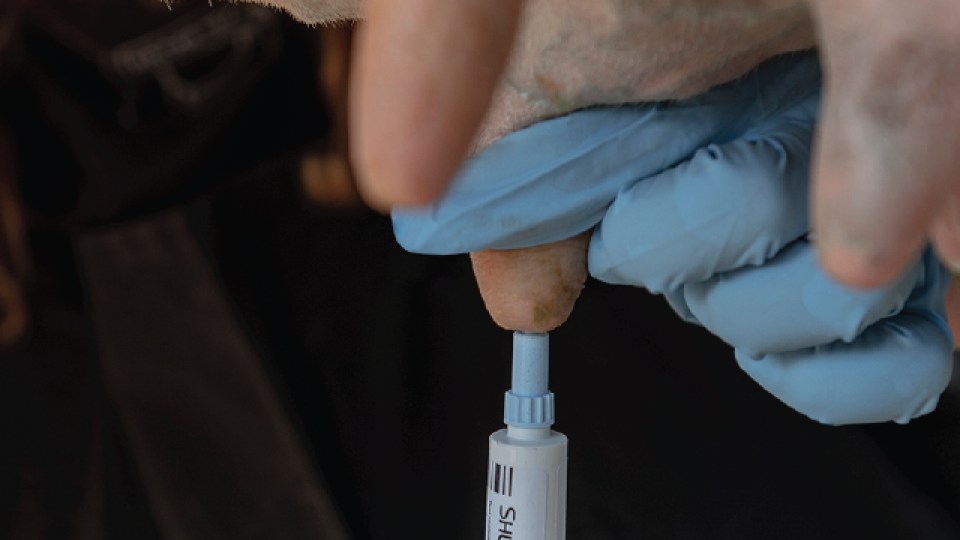Seven strategies to reduce dry period mastitis
By Dr. Brian Miller
Dairy cows are most susceptible to new intramammary infections (IMIs) during the dry period.1,2 IMIs acquired during the dry period can have a significant impact on milk production, milk quality, herd removal and reproductive performance post-calving.
Follow these seven strategies to help prevent new IMIs and set cows up for success post-calving.

1) Monitor teat end condition
If teat end condition is a concern at dry-off, the risk of new infections during the dry period increases.3 Milking procedures, equipment, environment and genetics all can affect teat condition. Diagnose causes and institute preventive solutions beforehand, to ensure teat ends are in good health at dry-off.
2) Consider an internal teat sealant (ITS)
A cow’s natural defense mechanism against mastitis is the formation of a keratin plug within the teat canal which seals teat ends from bacterial penetration during the dry period. Plug formation can be delayed or fail to form altogether.3,4 The use of an ITS, such as SHUTOUT®, has been shown to reduce the risk of developing an IMI by more than 70%.5
3) Consider blanket or selective dry cow therapy
The primary purpose of using dry-cow therapy is to cure existing IMIs acquired during lactation. Research has revealed that more than 94% of subclinical mastitis infections at dry-off are caused by Gram-positive bacteria.6,7 Therefore, select a dry-cow therapy product like ORBENIN-DC™ (cloxacillin benzathine intramammary infusion), which targets these bacteria.
4) Reduce teat end exposure to bacteria
The rate of IMIs in dairy cows is directly proportional to the exposure of teat ends to potential pathogens.8 Keep bedding, alleys, walkways, and crossovers clean to avoid manure transfer to the udder, legs and tail. More manure in a pen results in greater bacterial numbers, which amplifies mastitis risk.
5) Provide adequate ventilation and heat abatement
Impacts associated with heat stress include decreased appetite, immunosuppression and an increase in bacterial populations, elevating mastitis risk. There is evidence that heat stress during the dry period impairs fertility after calving.9 These findings underscore the importance of managing heat stress during the dry period.
6) Provide at least 30 inches of bunk space per cow
Research has linked overcrowding to increases in displaced abomasum, ketosis, and metritis.10 Theoretically, overcrowding results in stress which increases susceptibility to infectious diseases such as mastitis.
7) Consider a core-antigen vaccine
More than 50% of clinical coliform mastitis events that occur in the first 100 days in milk originate during the dry period.11 A J-5 core-antigen vaccine such as BOVILIS® J-5 helps cows recognize a coliform invader, such as E. coli, has entered its system and triggers an immune response. Refer to “Don’t Fall for These Core-Antigen Vaccine Myths” for more information about core-antigen vaccination.
Consult with your veterinarian to create a comprehensive dry cow management program to reduce dry period IMI risks.
IMPORTANT SAFETY INFORMATION:
IMPORTANT SAFETY INFORMATION FOR ORBENIN-DC: For use in dry cows only. Do not use within four weeks (28 days) of calving. Treated animals must not be slaughtered for food purposes within 4 weeks (28 days) of treatment. For additional information, see the product label.
IMPORTANT SAFTEY INFORMATION FOR BOVILIS J-5: This product contains oil adjuvant. In the event of accidental self-injection, seek medical attention immediately. For additional information, see the product label.
References
- Bradley, AJ, Green, MJ. The importance of the nonlactating period in the epidemiology of intramammary infection and strategies for prevention. Vet. Clin. North Am. Food Anim. Pract. 2004;20(3):547-68.
- Smith, KL., et al. Environmental pathogens and intramammary infection during the dry period. J. Dairy Sci. 1985;68(2):402-417.
- Dingwell, RT., et al. The association of teat canal closure and other risk factors for new dry period intramammary infections. Proceedings, National Mastitis Council 42nd Annu. Mtg. 2003;298-299.
- Williamson, JH., et al. The prophylactic effect of a dry-cow antibiotic against Streptococcus uberis. N. Z. Vet. J. 1995;228.
- Rabiee, AR, Lean, IJ. The effect of internal teat sealant products on intramammary infection, clinical mastitis, and somatic cell counts in lactating dairy cows. J. Dairy Sci. 2013;96(11):6915-6931.
- Johnson, AP., et al. Randomized noninferiority study evaluating the efficacy of 2 commercial dry cow mastitis formulations. J. Dairy Sci. 2016;99(1):593-607.
- Aruda, AG, et al. Randomized noninferiority clinical trial evaluating 3 commercial dry cow mastitis preparations, Part 1. J. Dairy Sci. 2013;96:4419-4435.
- Cook, NB, Reinemann DJ. A toolbox for assessing cow, udder and teat hygiene. Proceedings, National Mastitis Council 46th Annu. Mtg. 2007;31-43.
- Cook, N. University of Wisconsin-Madison, personal communication, 2020.
- Bradley, AJ, Green, AJ. A study of the incidence and significance of intramammary enterobacterial infections acquired during the dry period. J. Dairy Sci. 2000;83(9):2957-1965.
- Nordlund, K, Cook, N, Oetzel G. Commingling Dairy Cows: Pen Moves, Stocking Density, and Health. 39thProceedings, American Association Bovine Practitioners. 2006; 36-42.
Find more content for your beef operation.
About the author

Brian Miller
D.V.M.
Cattle Technical Services
Merck Animal Health
